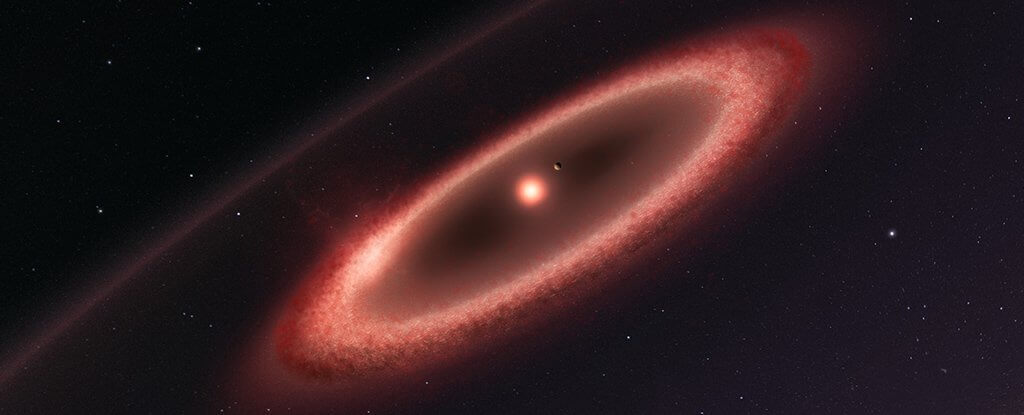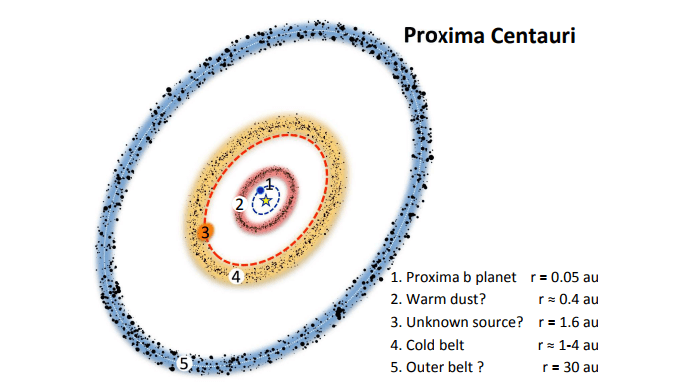
Astronomers announced the discovery of a cold ring of cosmic dust around nearby Solar system a star is a dim red dwarf Proxima Centauri. The opening suggests that this star, in addition is home to the nearest earth-like planet that scientists discovered last year, may be part of a much more complex planetary system than it was before.
Using data from Atkarskoy a large antenna array of millimeter range (ALMA), a complex of radio telescopes located in the Chilean Atacama desert, a team of researchers were able to determine the dim glow, which, as it turned out, is the belt of dust surrounding Proxima Centauri at a distance of several hundreds of millions of kilometers. Scientists say that the zone consists of various kinds of cosmic material (rocks, dust), as well as ice and has an extremely low temperature of about -230 degrees Celsius, which makes it as cold as the Kuiper belt in our Solar system.
As usually similar outer zone represents the excess of matter from the accretion disk rotating around the star and served as the source material for the formation of new planets, it would be logical to assume that within this star system may be considerably more planets than we have been able to date to locate.
“The presence of dust around Proxima is a very important indicator, as it is the first sign indicating the presence of more complex planetary systems and not just one planet,” says leader of the research project Guillem Anglada, an astronomer at the Astrophysical Institute of Andalusia.
Further collection of data has forced researchers to make a further assumption that the system can surround additional, even more cold belt of cosmic dust surrounding the star at a distance ten times further. After collecting and analyzing all the data, astronomers have created a small sketch of how really can look like the system Proxima Centauri (image below). Most researchers were intrigued by what lies at the distance of about 1.6 astronomical units from the star.

“According to one of the alternative models, on the border of the inner ring, at a distance of about 1.6 a. E. from the stars is an unknown source of interference, which may represent the planet. A giant planet,” say the researchers published the results of their work.
This “unknown source” is marked by number 3 in the image above. Despite the fact that earlier long-term observations Proximi Centauri showed no signs of the presence of such planets, researchers are not yet ready to exclude this possibility.
“For confirmation or refutation of this hypothesis will further monitor the system,” — added scientists.
To date, in the system of Proxima Centauri confirmed the presence of only one planet. The presence of Proxima b (the so-called planet), it was confirmed in August 2016, scientists from the European southern Observatory. It was also announced that Proxima b is closest to the Earth exoplanet located in the so-called habitable zone. Just a couple of months scientists have issued a new statement, announcing the completion of the calculations, which showed that Proxima b can be covered with liquid water and have a thin gaseous atmosphere, which certainly would increase the capacity of its potential habitability.
Earlier this year we found out that, despite its initial attractiveness, Proxima b has a serious drawback. And this lack is a red dwarf, is the star around which this planet revolves. Unstable behavior of dwarf and stellar wind, which he throws into the side of the planet, most likely, make it a pretty harsh place to live. Moreover, some astronomers believe that the power of this stellar wind is so strong that it literally blows away the thin atmosphere of Proxima b, making this the world is completely lifeless. Not all agree with these findings. There are, however, those who believe the planet is a Paradise and our future dwelling place.
Final conclusions about Proxima b to do is impossible. And most likely, the true state of Affairs around it we won’t know until then, until you send a spacecraft that could collect more scientific data. But we now know that there are several rings around the system, which can be an indicator of the presence of more planets in it. This, in turn, makes a space mission there even more desirable.
“These results hint at the presence of Proxima Centauri this system of planets with a rich history of interaction between them, which has led to the formation of this ring of dust,” says Anglada.
At the same time, the scientists added that the constant monitoring of nearby systems increases our knowledge about the birth of our own Solar system.
“Such observations, combined with studies of protoplanetary discs around young stars can open us up to many details about the processes that led to the formation of the Earth and the Solar system about 4.6 billion years ago,” says one of the team of researchers of the Astrophysical Institute of Andalusia, the astronomer Pedro Amado.
The findings described today’s research will soon be published in the journal Astrophysical Journal Letters.
Astronomers have solved one of the mysteries of our nearest star system
Nikolai Khizhnyak